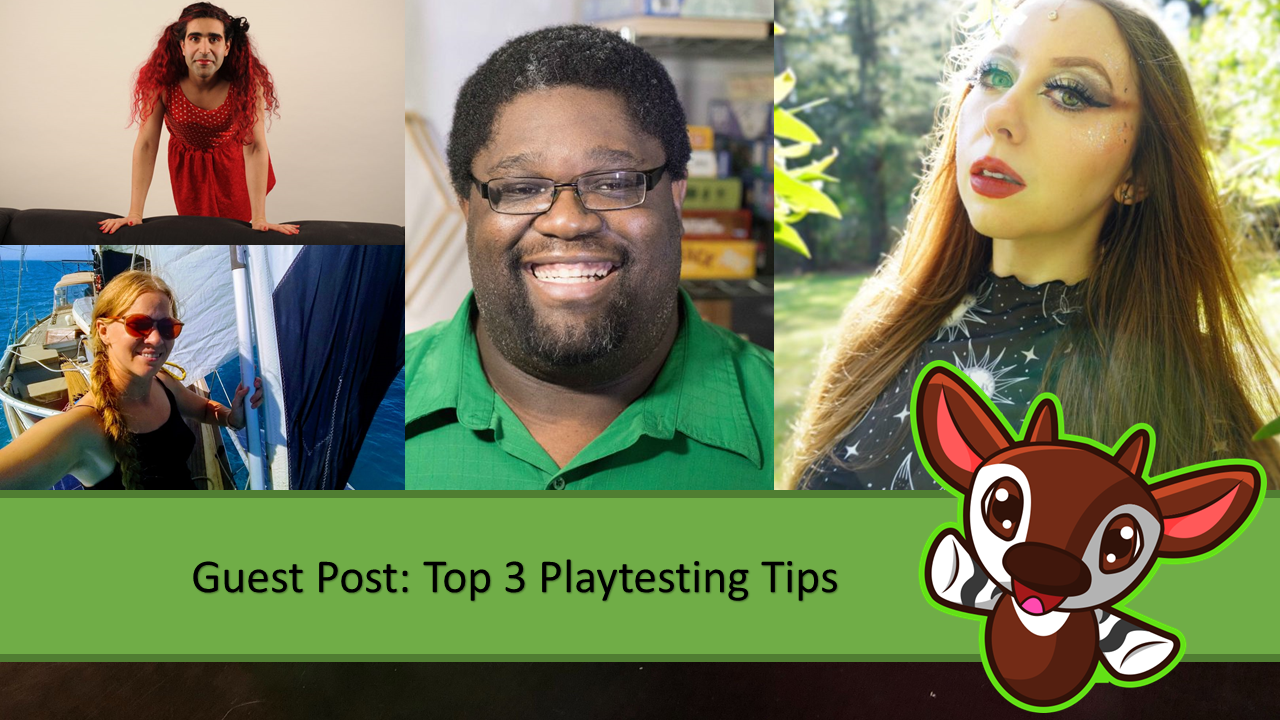
I know a lot of amazing designers, and I wanted to highlight some of them, which is why I have guest posts! Each post will be a question about design or publishing and will hopefully give you a variety of perspectives to learn from.
What are your top three playtesting tips?
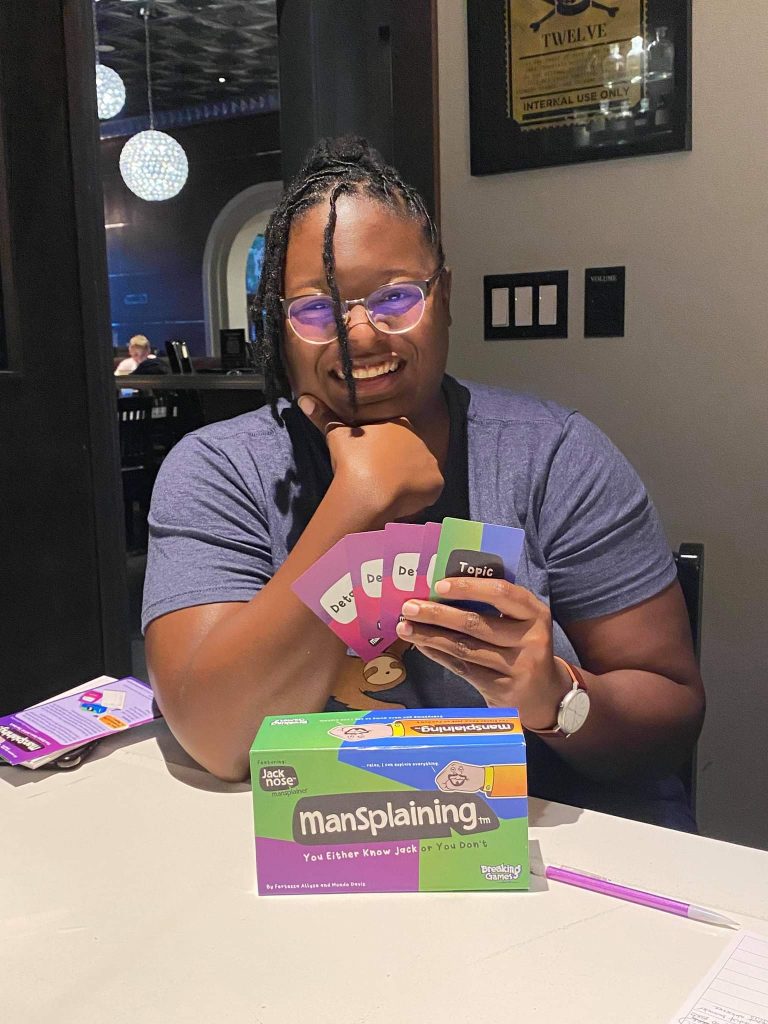
- Always bring a notebook with you and record what people say, what they do, and any awkward moments you observe. Even if people say never mind or discount what they’re saying, write it down. It came to mind for a reason, even if they don’t know what that reason is or they don’t feel justified in saying it. Ultimately when people are in their homes, they don’t have to justify why they don’t want to play a game. They just avoid it.
- You know that surge of frustration when someone tells you something that’s the exact opposite of what a previous playtester told you? Or the suggestion someone gives that you already tried? Resist that urge to snark when that happens. It just makes the playtester feel bad and it doesn’t make you look good either. Instead of responding in frustration, try saying ” I’ve tried X, but it didn’t address Y. It caused Z. I’m not sure how to address it, but I’m thinking on it.” It let’s them know they’ve been heard, and potentially paves the way for additional feedback.
- Set the tone for feedback. Once the game ends, identify if anyone has to leave earlier than others, or who is more eager to speak. Have them start off the feedback. I always try to make sure everyone knows I’m writing notes and that I need them to go one at a time to intake everything they say. Otherwise you run the risk of getting people talking over one another for half an hour and never letting other parts of the group speak. If someone is long-winded then try to save time for them after everyone else has gone, but also feel empowered to end the feedback session if they are beating a dead horse.” – Fertessa Allyse, @fertessa

- Buy pizza for everyone. Most play-testers aren’t paid for their time, so the least you can do is feed them by way of thanks for showing up.
- Make sure to find play-testers outside of your immediate friends and family. You’re likely to get more candid feedback.
- Other designers are generally the best play-testers in terms of giving the most useable feedback.

- Playtest Often – Both for your game and for others! When you do playtest, be sure to have one or a few focal areas that you want to gain input on and try to ask questions that begin with How or What, like “How did X feel” or “What do you think about Y.
- Playtest in Different Circles – It’s fine to have your circle of choice, whether it be in person or online, but when trying to get a variety of feedback and input on your game from people from all walks of life, you might find more success if you playtest your game in other places as well.
- Take a Break – Burnout is real! Whether you turn your focus to a different game or pause playtesting altogether for a period of time, make sure to give you and your game a bit of grace as you navigate through this part of the game development process.” – Raven McKenzie, @_RavenMcKenzie

- It is easier to pay attention to what is happening in the game if you are not playing it yourself. Try to observe whenever possible.
- Use a stopwatch. Measure the turns, the rounds, the phases, etc. Determine which parts of the game take the longest and then decide whether they provide enough value to justify the cost in time.
- New players are the most important demographic because they won’t become regulars if they don’t like your game on their first playthrough. Weight their opinions over those of players that have already tried your game many times.” – Ananda Guneratne, @AnandaGuneratne

- “The most important tip I have is to make creating a safe testing environment your first priority. If your players don’t feel like their voice is welcome, they’re less likely to engage and share helpful feedback.
- Engage the players in the creative process. If they’re confused about how a mechanic works, ask them, “What do you want it to be?” Involving them in that process can help you figure out what makes your systems more fun/intuitive and gives the players a sense of investment and inclusion.
- Don’t try to fix every problem in one playtest. Fixing multiple problems at once often leads to the creation of a whole new game instead of a new iteration of your original prototype. Pick out one of the biggest problems and only fix that one before your next playtest.” – Sara Perry, @saraperry96

- “Iterate as soon as possible. It doesn’t matter if it’s pretty or on TTS or hand written on index cards, just get it out of your brain. I tend to forget chunks of ideas if I take too long to iterate, and by the time I get it all out, I’m always missing something from the original idea. Sometimes I’ll remember it later on down the line, but sometimes it’s lost to the ether.. forever!
- Get your design in front of as many people as you can. There’s going to be things you (or your personal playtesting group) don’t see or realize, that a fresh set of eyes will easily spot. It’s going to be super helpful to have other check your design blindspots.
- Resist the urge to change everything after only one or two playtests. I’m one of the worst when it comes to this. I see a problem in a game and I attempt to fix it, without stopping to wonder if the thing is ACTUALLY a problem vs. a simple outlier that might not come up in most situations.” – David J. Bruglia, @DavidBruglia

Uwww, playtesting! The ‘fun’ part. Okay.
- Practice how you plan to explain your game. The teach is really important in setting the tone, and helping playtesters get an understanding of what feel you’re aiming to create.
- Once feedback begins (whether that’s intermittently during the game or after, I encourage after) let playtesters know what kind of feedback you’re looking for. Sometimes this is good to note before the game even begins (usually in the later stages of playtesting), because it helps guide playtesters to evaluate the specific areas you’re working on.
- Assist and encourage your playtesters. It’s almost inevitable that there will be mid-game questions, encourage them. If a player seems stuck, or excited, or particularly interest in a tactic/strategy or component, ask them about it. This might be an opportunity to learn which parts of the game are most intriguing, or which parts are confusing or less difficult.” – Jadyne (Jay) Bell, @thejaybell
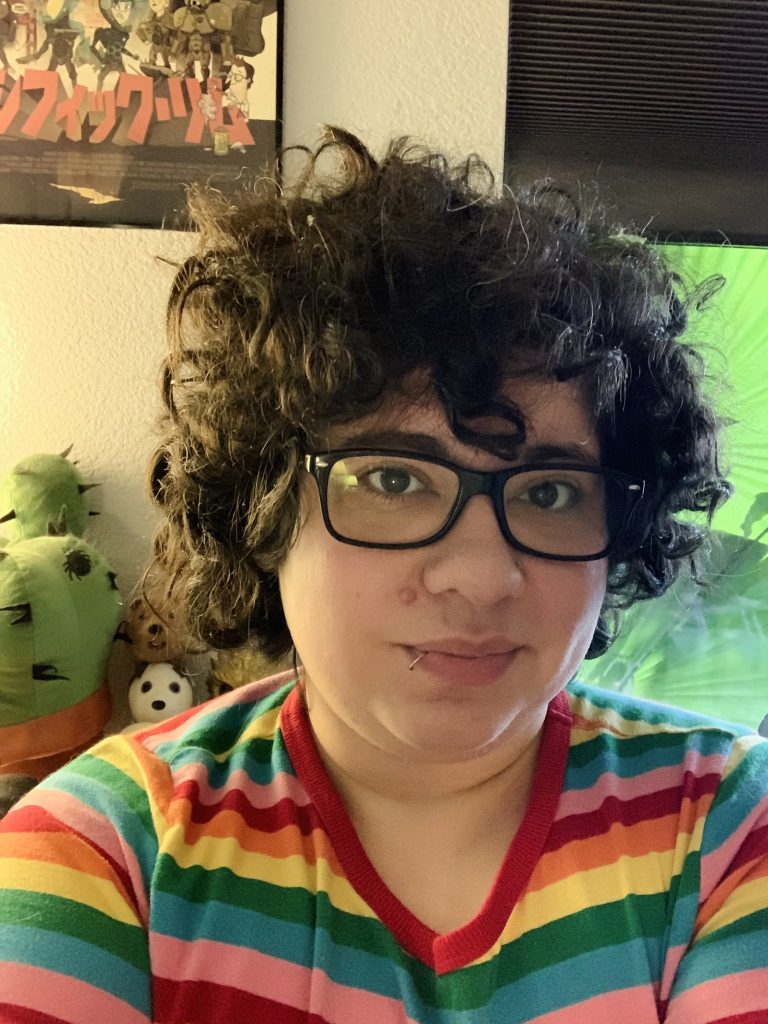
- “Be flexible with game. The game will most likely evolve as you play and figure out what works and what doesn’t. Don’t be afraid to make changes.
- Listen to what people have to say about their experience of your game. Their ideas for “fixing” things may not be the correct ones for your game’s style, but their experience is very important.
- Trust your gut. Don’t change everything about your game because different people don’t like different things about your game. You have to decide what you are really trying to accomplish. It’s a tricky balance but it’s all your goals and trusting yourself.” – Estefania Rodriguez, @estefaniar88
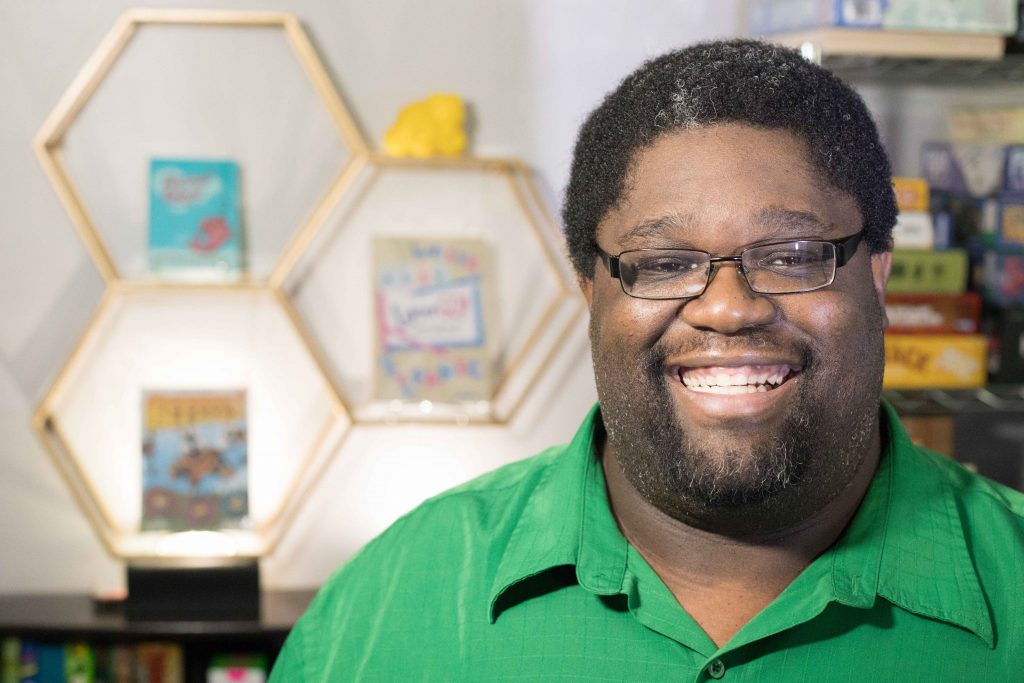
- “Be open to the process. Your game is not done, that’s why you’re testing. In the best playtest I ever saw the designer updated a card’s values on the spot during the player’s turn to match how they felt it should play.
- Know your goal for each test and try to observe the effect of each rule in your game. Matching the mood of the game to the players’ feelings are my general guide. If a rule feels “fiddly” it probably doesn’t belong in a party game.
- Teach, but don’t play the game if possible. Explain the rules, but try not to offer strategies to see if players come up with novel solutions on their own. It’s easier to take notes when you’re not interpreting your own play and directly influencing the play strategies your testers would otherwise have tried.” – Marcus Ross, @waterbeargames

- “Practice your teach before the session and review your changes from your game’s last version. Teaching your game correctly and well can lead to different experiences so make sure you rehearse!
- Have a playtest goal for the session whether it is to just see if the main mechanic works, if doing X strategy is broken, or if a specific card needs tweaking.
- Take excessive notes! You never know when certain things becomes more relevant in the future.” – Tony Tran, @tonymakesgames

- “Take notes. Take notes during play so you can ask specific questions about moments that happened. It’s also helpful to train yourself to write instead of talking. You’ll learn a lot more listening to the players than you will from hearing yourself speak. Also be sure to take notes on feedback you receive at the end of the playtest, so you can refer back to your notes as you improve your game. Don’t rely on remembering everything. You’ll lose some gems that way!
- Make sure everyone gets to provide feedback. Some playtesters will be more vocal than others, but everyone has value to add. Not only could you miss out on some important feedback if you don’t give everyone a chance, but it’s also inconsiderate to use someone’s time and not treat them like you value their thoughts. Speaking of being considerate of time…
- Use a timer. Playtime is great information all its own. Plus, you’ll will be able to give accurate estimates for future playtests. Once the timer is approaching the limit that you committed to, offer to wrap things up and get feedback for that session. If you want a complete game, you can always give a better estimate next time. People’s time is valuable, so treat it that way. And sometimes, players will beg you to finish anyway. That’s fantastic feedback!” – Kirsten Lunde, @lookingglassws

- “Avoid leading questions.
- Observe physical behaviors. This will give you insight on what the playtester might not even be able to voice at the time. Example: maybe an interaction was frustrating at first but in a later turn pays off. The playtester might only feedback on only that final emotion. I can ask them about this whole journey if I observed them carefully.
- Don’t worry about your game’s balance that much during most tests. Focus on the feeling and journey of your game. Once that is locked in, you can use your dedicated returning playtesters to iron out these issues later in the process.” – Chris Solis, @CGCFOX

- Playtest asap, starting with yourself, then with others. Don’t worry about it being perfect, don’t waste timing making things pristine, things will need to change.
- Make use of the excellent online communities if you can put your prototype in Tabletop Simulator! Cardboard Edison has an excellent directory of such groups.
- Read into how your playtesters emotionally respond to your game, this is possibly even more valuable than their feedback in some cases.” – Katie Allred, @RedCheshireKate
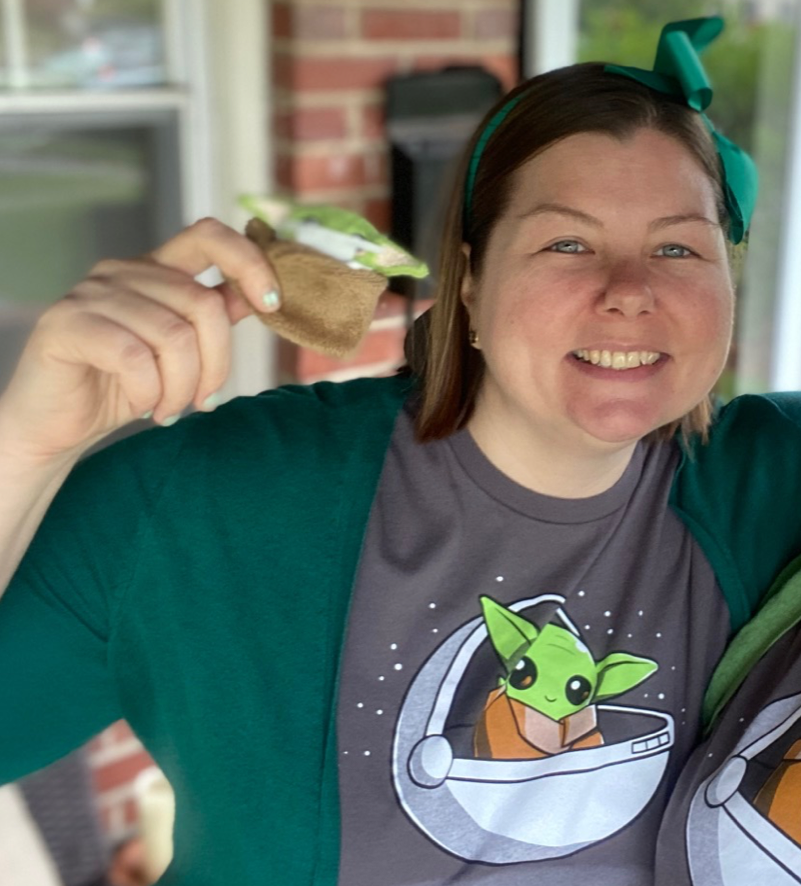
- “Allow all players to play, don’t interject with strategy tips.
- Look for recurring feedback and address. Don’t just take one person’s opinion into account.
- Be willing to take out the thing YOU LOVE if it’s not working after a good amount of playtesting. Maybe that element is better suited for another game.” – Heather O’Neill, @catphysicist
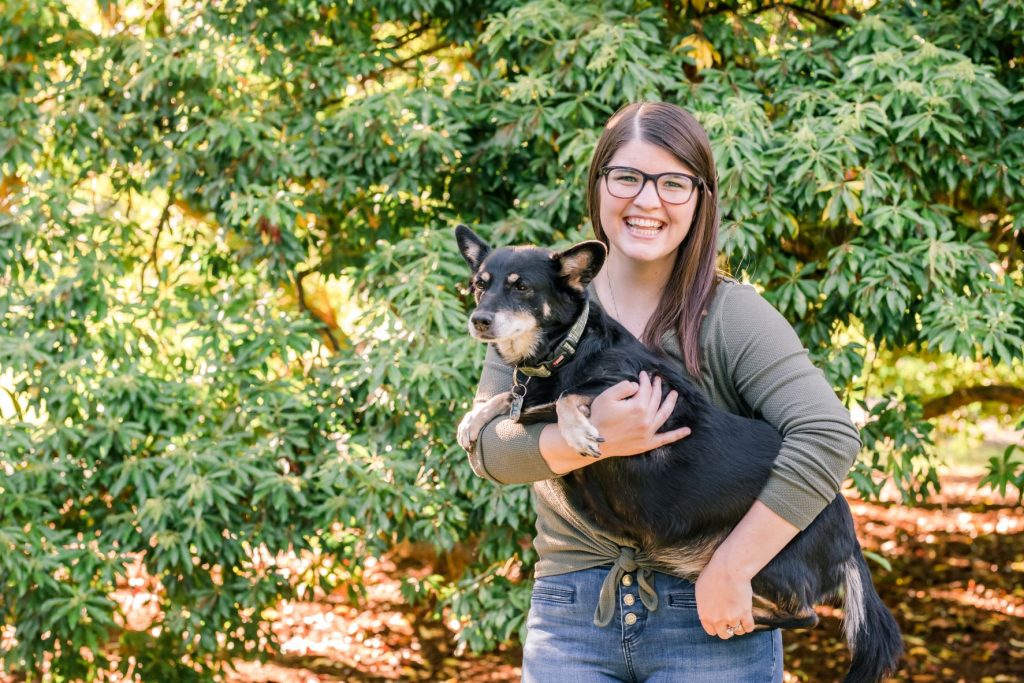
- “Listen attentively to your playtesters when receiving feedback, and do not get defensive when you disagree with their feedback.
- Be respectful and thank your playtesters. I try to set clear expectations of how much time I expect the playtest to take, and I check in with playtesters if I start to approach the expected amount of time to see if they’re comfortable continuing. I also try to set the expectation that if a playtester would like to stop early for any reason, that is 100% encouraged and we can go into feedback at any time.
- Give back more than you receive. Aside from it being the right thing to do, playtesting other designers’ games is an amazing way to network and learn from other designers.” – Courtney Shernan, @CourtneyShernan

- “Just do it! You need to play with people outside your friends and family. It might take some courage, but other designers are very friendly and encouraging.
- Be open to feedback from others. Don’t get defensive or offended, they’re all trying to help. Even if the feedback is not quite what you’re aiming for, write it down and move on.
- Try to keep track of your feedback in a notebook or word doc. It could help in the future to see what and why things changed in your game, how often an issue comes up, or any other information about your development.” – Amelie Le-Roche, @zeruagames

- “Listen to feedback and thank people for their thoughts. Not all feedback will always be valid or valuable but you have to be careful to never invalidate your playtesters’ feedback. When they generously provide their time to play your game you need to be respectful of what they say. That does mean resisting the urge to be defensive and verbally justify why your design is the way it is.
- Know how to pick out valuable signals in feedback. In general players who aren’t designers are good at identifying problems and not necessarily solutions. Playtesters will sometimes propose a change in design but what you need to do is identify what problem they are trying to solve. It’s your job as the designer/developer to figure out the best solution and that starts by making sure you understand the problem that needs solving.
- Ask, don’t tell. After the rules have been explained and someone has a question about a particular card or interaction, rather than telling them how it works, ask them how they think it works before clarifying. This helps reveal what is intuitive to players and can highlight areas of confusion in your rules or graphic design. A good design goal is to make everything as intuitive as possible without breaking the game.” – Joseph Z Chen, @fanfactories

- “Be open-minded when receiving feedback. Your game isn’t perfect. It never will be, but you need help to get it to be as good as it can be.
- Get a wide variety of people to playtest your game, not just your target audience. New perspectives are invaluable.
- Have specific questions you want playtesters to answer, but leave time for open discussion.” – Sarah Reed, @EuroGamerGirl

- “1. There comes a time in playtesting when you need to remove yourself from the equation. Eventually, even your presence will “contaminate” the playtest – especially if you’re testing with your friends or family! Instead, create a form with all the feedback you’re looking to gather and let players fill it out anonymously. Record the playtest if you have the players’ permission. This way, you can get that brutally honest feedback that you need!
- Before each playtest, identify a goal. Especially when your game is at an early stage, it can be overwhelming to address each little improvement that your game needs. Instead, focus on one thing that you feel like you can address in the playtest, for example a player’s turn structure, or the size of your battle map.
- Document everything! It’s so easy to just assume you’ll remember all the important points from a playtest, then have it fly out of your head right after. I like keeping a journal just for playtesting, with each game in its own section. Take tons of notes during your playtest so nothing is missed or forgotten.” – Brenna Noonen, @brennanoonan

- “Playtest as soon as possible, before you invest time or money in art. I’ve playtested a lot of games that looked beautiful, but there was no fun in the game yet, so the design work was wasted time and money. Not only that, but it prevented me from making sweeping changes that needed to be made, because I was attached to the look or the story I had created. It’s better to playtest a lot of bare bones (aka ugly) game concepts and edit as you go than to wait to make a big “reveal” of something the first time you playtest, and then have to change it all. This was as especially hard for me as a graphic designer. But once I started playtesting ugly games, I was able to make quicker progress and create better games.
- Shut up and listen! Don’t spend time being defensive about criticism. Playtesters are not there because they want to pass judgement on you. They want to help you make it better. Embrace this with gratitude. As you listen, try to capture the symptoms that the playtesters describe. Then you can identify the underlying problems and try out solutions.
- Aim for quality over quantity in playtests. You can do this by focusing on making good connections with playtesters. Check out the “Break My Game” discord server to connect with other playtesters any day of the week. They are an extremely helpful community, and provide very useful insights. If you have someone playtest, make a note and try to circle back with them to try out the next iteration of the game to see if it’s improved.” – Emily Willix

- “Feel free to change a game half-way through, or stop/restart, but check in with playtesters.
- Listen. Don’t talk, except to guide the feedback/conversation.
- Don’t fret about what you wanted the game to be like. Just think about what the best version of this game could be. If part of the game is surprisingly fun/engaging, then explore that, even if it means cutting away your initial inspiration.” – Bez, @stuffbybez
Did you enjoy this entry? Which designers would you want to hear from next? Please let me know! I’d love to hear what you think and what kind of things you’d like to see from this blog. Feel free to send me an email or comment with your thoughts!
Don’t forget to sign up for my mailing list, so you don’t miss a post: https://tinyletter.com/carlakopp